Spatial and Temporal Variation of Drought Based on Satellite Derived Vegetation Condition Index in Nepal from 1982–2015
Abstract
1. Introduction
2. Study Area and Data
2.1. Study Area
2.2. Data Acquisition
3. Methods
3.1. Identification of the Drought
3.2. Drought Trend Analysis
3.3. Trend Detection of the VCI Drought Index
3.4. Anomaly Vegetation Condition Index
3.5. Exceedance Probability and Return Periods
3.6. Correlation Analysis of the VCI and Climate Factors
4. Results
4.1. Temporal Variation of VCI
4.2. Spatial Variation of VCI
4.3. Spatial and Temporal Drought Trends
4.4. Anomaly Vegetation Condition Index
4.5. Exceedence Probability and Return Periods
4.6. Relation between VCI and Climatic Factors from 1982–2015 in Nepal
5. Discussion
5.1. Identification and Temporal Variations of VCI from 1982–2015
5.2. Spatial Variation of the VCI from 1982–2015
5.3. Probability of Occurring Severe Drought and Drought Based on the VCI Index
5.4. Relationship between VCI and Climates
5.5. Uncertainty, Validation and Applicability of VCI-Based Drought Study
6. Conclusions
Author Contributions
Funding
Acknowledgments
Conflicts of Interest
References
- Wilhite, D.A. Drought as a natural hazard—Concepts and definitions. In Drought: A Global Assessment; Routledge: London, UK, 2000; Volume I, pp. 3–18. [Google Scholar]
- Mishra, A.K.; Singh, V.P. A review of drought concepts. J. Hydrol. 2010, 391, 204–216. [Google Scholar] [CrossRef]
- Jiao, W.Z.; Zhang, L.F.; Chang, Q.; Fu, D.J.; Cen, Y.; Tong, Q.X. Evaluating an enhanced vegetation condition index (vci) based on viupd for drought monitoring in the continental united states. Remote Sens. 2016, 8, 224. [Google Scholar] [CrossRef]
- McKee, T.B.; Doesken, N.J.; Kleist, J. The relationship of drought frequency and duration to time scales. In Proceedings of the 8th Conference on Applied Climatology, American Meteorological Society, Anaheim, CA, USA, 17–22 January 1993. [Google Scholar]
- Berner, L.T.; Beck, P.S.A.; Bunn, A.G.; Lloyd, A.H.; Goetz, S.J. High-latitude tree growth and satellite vegetation indices: Correlations and trends in russia and canada (1982–2008). J. Geophys. Res. Biogeosci. 2011, 116. [Google Scholar] [CrossRef]
- Masud, M.B.; Khaliq, M.N.; Wheater, H.S. Analysis of meteorological droughts for the saskatchewan river basin using univariate and bivariate approaches. J. Hydrol. 2015, 522, 452–466. [Google Scholar] [CrossRef]
- Beck, H.E.; McVicar, T.R.; Dijk, A.V.; Schellekens, J.; Jeu, R.A.; Bruijnzeel, L.A. Global evaluation of four avhrr–ndvi data sets: Inter-comparison and assessment against landsat imagery. Remote Sens. Environ. 2011, 115, 2547–2563. [Google Scholar] [CrossRef]
- Zhang, Q. Drought and its impacts. In China Climate Impact Assessment; Chen, H., Ed.; China Meteorol Press: Beijing, China, 2003; pp. 12–18. [Google Scholar]
- FAO. Report of Fao-Crida Expert Group Consultation on Farming System and Best Practices for Drought-Prone Areas of Asia and the Pacific Region; Food and Agricultural Organization of United Nationas, Central Research Institute of Drylands Agriculture: Hyderbad, India, 2002. [Google Scholar]
- World Bank. Report on Financing Rapid Onset Natural Disaster Losses in India: A Risk Management Approach; Report No.26844-IN; World Bank: Washington, DC, USA, 2003. [Google Scholar]
- Joshi, G.R. Agricultural Economy of Nepal: Development Challenges and Opportunities; Sustainable Research and Development Center: Kathmandu, Nepal, 2018. [Google Scholar]
- Sigdel, M.; Ikeda, M. Spatial and temporal analysis of drought in nepal using standardized precipitation index (spi) and its relationship with climate indices. J. Hydrol. Meteorol. 2010, 7, 59–74. [Google Scholar] [CrossRef]
- Kafle, H.K. Spatial and temporal variation of drought in far and mid western regions of nepal: Time series analysis (1982–2012). Nepal J. Sci. Technol. 2014, 15, 65–76. [Google Scholar] [CrossRef]
- Wang, S.Y.; Yoon, J.H.; Gillies, R.R.; Cho, C.R. What caused the winter drought in western nepal during recent years? J. Clim. 2013, 26, 8241–8256. [Google Scholar] [CrossRef]
- Dahal, P.; Shrestha, M.; Panthi, J.; Pradhanang, S.M. Drought risk assessment in centralnepal: Temporal and spatial analysis. Nat. Hazards 2015, 80, 1913–1932. [Google Scholar]
- Panthi, S.; Brauning, A.; Zhou, Z.K.; Fan, Z.X. Tree rings reveal recent intensified spring drought in the central himalaya, nepal. Glob. Planet. Chang. 2017, 157, 26–34. [Google Scholar] [CrossRef]
- Gaire, N.P.; Dhakal, Y.R.; Shah, S.K.; Fan, Z.X.; Brauning, A.; Bhandari, S.; Aryal, S.; Bhuju, D. Drought (scpdsi) reconstruction of trans-himalayan region of central himalaya using pinus wallichiana tree-rings. Palaeogeogr. Palaeoclimatol. Palaeoecol. 2018, 514, 251–264. [Google Scholar] [CrossRef]
- UNDP. United nations development program. Country report climate risk management for agricultural in nepal. In Regional Integrated Multi-Hazards Early Warning System for Africa and Asia; UNDP: New York, NY, USA, 2013. [Google Scholar]
- NAPA. National Adaptation Program in Action (Napa) to Climate Change, Ministry of Environment (MOE); Government of Nepal (GON): Kathmandu, Nepal, 2010.
- Shrestha, M.L. Interannual variation of summer monsoon rainfall over nepal and its relation to southern oscillation index. Meteorol. Atmos. Phys. 2000, 75, 21–28. [Google Scholar] [CrossRef]
- Sigdel, M.; Ikeda, M. Seasonal contrast in precipitation mechanisms over nepal deduced from relationship with the large-scale climate patterns. Nepal J. Sci. Technol. 2012, 13. [Google Scholar] [CrossRef]
- DHM. Study of Climate and Climatic Variation over Nepal; Department of Hydrology and Meteorology (DHM): Kathmandu, Nepal, 2015.
- Shrestha, A.B.; Wake, C.P.; Mayewski, P.A.; Dibb, J.E. Maximum temperature trends in the himalaya and its vicinity: An analysis based on temperature records from nepal for the period 1971–1994. J. Clim. 1999, 12, 2775–2786. [Google Scholar] [CrossRef]
- Sharma, K.P. Maximum temperature trends in nepal. In An Analysis Based on Temperature Records from Nepal for the Period 1975–2007; Department of Hydrology and Meteorology (DHM): Babarmahal, Kathmandu, 2009. [Google Scholar]
- Baniya, B.; Tang, Q.; Huang, Z.; Sun, S.; Techato, K.-A. Spatial and temporal variation of ndvi in response to climate change and the implication for carbon dynamics in nepal. Forest 2018, 9, 329. [Google Scholar] [CrossRef]
- DHM. Observed Climate Trend Analysis in Nepal (1971–2014); Department of Hydrology and Meteorology: Kathmandu, Nepal, 2017.
- Ghimire, Y.N.; Shivakoti, G.P.; Perret, S.R. Household-level vulnerability to drought in hill agriculture of nepal: Implications for adaptation planning. Int. J. Sustain. Dev. World Ecol. 2010, 17, 225–230. [Google Scholar] [CrossRef]
- Gumma, M.K.; Gauchan, D.; Nelson, A.; Pandey, S.; Rala, A. Temporal changes in rice-growing area and their impact on livelihood over a decade: A case study of nepal. Agric. Ecosyst. Environ. 2011, 142, 382–392. [Google Scholar] [CrossRef]
- Palmer, W.C. Meteorological Drought; U.S. Department of Commerce Weather Bureau: Washington, DC, USA, 1965.
- Palmer, W.C. Keeping track of crop moisture conditions, nationwide: The new crop moisture index. Weatherwise 1968, 21, 156–161. [Google Scholar] [CrossRef]
- Hollinger, S.E.; Isard, S.A.; Welford, M.R. A new soil moisture drought index for predicting crop yields. In Proceedings of the Preprints, Eighth Conference on Applied Climatology, Anaheim, CA, USA, 17–22 January 1993; pp. 187–190. [Google Scholar]
- Meyer, S.J.; Hubbard, K.G.; Amer Meteorol, S.O.C. Extending the Crop-Specific Drought Index to Soybean; American Meteorological Society: Boston, MA, USA, 1995; pp. 258–259. [Google Scholar]
- Penman, H.L. Natural evaporation from open water, bare soil and glass. Proc. R. Soc. Lond. 1948, 193a, 120–146. [Google Scholar]
- Thornthwaite, C.W. An approach toward a rational classification of climate. Geogr. Rev. 1948, 38, 55–94. [Google Scholar] [CrossRef]
- Thornthwaite, C.W. Drought. In Encyclopedia Britannica; Oak Knoll Press: New Castle, DE, USA, 1963. [Google Scholar]
- Keetch, J.J.; Byram, G.M. A Drought Index for Forest Fire Control; Southeastern Forest Experiment Station: Asheville, NC, USA, 1968.
- Hayes, M.J. Drought Indexes; National Drought Mitigation Center, University of Nebraska–Lincoln: Lincoln, NE, USA, 1996; p. 7. [Google Scholar]
- Mendicino, G.; Senatore, A.; Versace, P. A groundwater resource index (gri) for drought monitoring and forecasting in a mediterranean climate. J. Hydrol. 2008, 357, 282–302. [Google Scholar] [CrossRef]
- Mirabbasi, R.; Anagnostou, E.N.; Fakheri-Fard, A.; Dinpashoh, Y.; Eslamian, S. Analysis of meteorological drought in northwest iran using the joint deficit index. J. Hydrol. 2013, 492, 35–48. [Google Scholar] [CrossRef]
- Rouse, J.J.; Haas, R.H.; Schell, J.A.; Deering, D.W. Monitoring vegetation systems in the great plains with erts. Nasa Spec. Publ. 1974, 351, 309. [Google Scholar]
- Sandholt, I.; Rasmussen, K.; Andersen, J. A simple interpretation of the surface temperature/vegetation index space for assessment of surface moisture status. Remote Sens. Environ. 2002, 79, 213–224. [Google Scholar] [CrossRef]
- Kogan, F.N. Remote sensing of weather impacts on vegetation in non-homogeneous areas. Int. J. Remote Sens. 1990, 11, 1405–1419. [Google Scholar] [CrossRef]
- Sha, S.; Guo, N.; Li, Y.H.; Ren, Y.L.; Li, Y.P. Comparison of the vegetation condition index with meteorological drought indices: A case study in henan province. J. Glaciol. Geocryol. 2013, 35, 990–998. [Google Scholar]
- Liu, W.T.; Kogan, F.N. Monitoring regional drought using the vegetation condition index. Int. J. Remote Sens. 1996, 9, 761–2782. [Google Scholar] [CrossRef]
- Jain, S.K.; Keshri, R.; Goswami, A. Application of meteorological and vegetation indices for evaluation of drought impact: 325 a case study for rajasthan, india. Nat. Hazards 2010, 54, 643–656. [Google Scholar] [CrossRef]
- Qian, X.J.; Liang, L.; Shen, Q.; Sun, Q.; Zhang, L.P.; Liu, Z.X.; Zhao, S.H.; Qin, Z.H. Drought trends based on the vci and its correlation with climate factors in the agricultural areas of china from 1982 to 2010. Environ. Monit. Assess. 2016, 188, 639. [Google Scholar] [CrossRef]
- Liang, L.; Sun, Q.; Luo, X.; Wang, J.H.; Zhang, L.P.; Deng, M.X. Long-term spatial and temporal variations of vegetative drought based on vegetation condition index in china. Ecosphere 2017, 8. [Google Scholar] [CrossRef]
- Domenikiotis, C.; Spiliotopoulos, M.; Tsiros, E.; Dalezios, N.R. Early cotton yield assessment by the use of the noaa/avhrr derived vegetation condition index (vci) in greece. Int. J. Remote Sens. 2004, 25, 2807–2819. [Google Scholar] [CrossRef]
- Deng, M.X.; Di, L.P.; Han, W.G.; Yagci, A.L.; Peng, C.M.; Heo, G. Web-service-based monitoring and analysis of global agricultural drought. Photogramm. Eng. Remote Sens. 2013, 79, 929–943. [Google Scholar] [CrossRef]
- Heim, R.R. A review of twentieth-century drought indices used in the united states. Bull. Am. Meteorol. Soc. 2002, 83, 1149–1165. [Google Scholar] [CrossRef]
- Gu, Y.; Ni, S.; Lin, J.; Dan, X.; Liu, J. China’s drought disaster situation changes and distribution characteristics. China Water Resour. 2011, 13, 27–30. [Google Scholar]
- Uddin, K.; Shrestha, H.L.; Murthy, M.S.R.; Bajracharya, B.; Shrestha, B.; Gilani, H. Development of 2010 national land cover database for the nepal. J. Environ. Manag. 2015, 148, 82–90. [Google Scholar] [CrossRef] [PubMed]
- Harris, I.; Jones, P.D.; Osborn, T.J.; Lister, D.H. Updated high-resolution grids of monthly climatic observations - the cru ts 3.10 dataset. Int. J. Climatol. 2014, 34, 623–642. [Google Scholar] [CrossRef]
- Mosier, T.M.; Hillb, D.F.; Sharp, K.V. 30-arcsecond monthly climate surfaces with global landcoverage. Int. J. Climatol. 2014, 34, 2175–2188. [Google Scholar] [CrossRef]
- Tucker, C.; Pinzon, J.E.; Brown, M.E.; Slayback, D.A.; Pak, E.; Mahoney, R.; Vermote, E.F.; Saleous, N.E. An extended avhrr 8-km ndvi dataset compatible with modis and spot vegetation ndvi data. Int. J. Remote Sens. 2005, 26, 4485–4498. [Google Scholar] [CrossRef]
- Holben, B.N. Characteristics of maximum value composite (mvc) images from temporal avhrr data. Int. J. Remote Sens. 1986, 7, 1417–1434. [Google Scholar] [CrossRef]
- Kogan, F.; Sullivan, J. Development of global drought-watch system using noaa avhrr data. Adv. Space Res. 1993, 13, 219–222. [Google Scholar] [CrossRef]
- Dutta, D.; Kundu, A.; Patel, N.R.; Saha, S.K.; Siddiqui, A.R. Assessment of agricultural drought in rajasthan(india) using remote sensing derived vegetation condition index (vci) and standardized precipitation index (spi). Egypt. J. Remote Sens. Space Sci. 2013, 18, 53–63. [Google Scholar] [CrossRef]
- Kogan, F.N. Application of vegetation index and brightness temperature for drought detection. Adv. Space Res. 1995, 15, 91–100. [Google Scholar] [CrossRef]
- Kogan, F.N. Droughts of the late 1980s in the united states as derived from noaa polar-orbiting satellite data. Better understanding of earth environment. Bull. Am. Meteorol. Soc. 1995, 76, 655–668. [Google Scholar] [CrossRef]
- Kogan, F.N. Global drought watch from space. Bull. Am. Meteorol. Soc. 1997, 78, 621–636. [Google Scholar] [CrossRef]
- Rimkus, E.; Stonevicius, E.; Kilpys, J.; Maciulyte, V.; Valiukas, D. Drought identification in the eastern baltic region using ndvi. Earth Syst. Dyn. 2017, 8, 627–637. [Google Scholar] [CrossRef]
- Guan, X.D.; Guo, N.; Huang, J.P.; Ge, J.M.; Zhang, Z.H. Applicability analysis of vci to monitoring northwest china drought. Plateau Meteorol. 2008, 27, 1046–1053. [Google Scholar]
- Yan, Y.; Xiao, F.; Du, Y.; Ling, F.; Li, X.D.; Li, Y.Z. Monitoring droughts in the five provinces along the middle-lower reaches of the yangtze river during spring/summer 2011 using avci. Resources and environment in the yangtze basin. Plateau Meteorol. 2012, 21, 1154–1159. [Google Scholar]
- Zhang, G.; Xu, X.; Zhou, C.; Zhang, H.; Ouyang, H. Response of grassland vegetation to climate variations on different temporal scales in hulun buir grasslands in the past 30 years. J. Geogr. Sci. 2011, 21, 634–650. [Google Scholar] [CrossRef]
- Kendall, M.G. Rank Correlation Methods; Charles Griffin: London, UK, 1975. [Google Scholar]
- Mann, H.B. Nonparametric tests against trend. Econometrica 1945, 13, 245–259. [Google Scholar] [CrossRef]
- Gilbert, R.O. Statistical Methods For Environmental Pollution Monitoring; Van Nostrand Reinhold Company: New York, NY, USA, 1987; p. 320. [Google Scholar]
- Sen, P.K. Estimates of the regression coefficient based on kendall’s tau. J. Am. Stat. Assoc. 1968, 63, 1379–1389. [Google Scholar] [CrossRef]
- Reddy, P.J.R. A Text Book of Hydrology; University Science Press: New Delhi, India, 2008. [Google Scholar]
- Quiring, S.M.; Ganesh, S. Evaluating the utility of the vegetation condition index (vci) for monitoring meteorological drought in texas. Agric. Meteorol. 2010, 150, 330–339. [Google Scholar] [CrossRef]
- Sigdyal, K.P. Save ecological balance: Environment problems and their solution in nepal, nepal nature’s paradise; insight in to diverse facets of topography, flora and ecology. J. Agric. Environ. 1999, 9. [Google Scholar] [CrossRef]
- Rayback, S.A.; Shrestha, K.B.; Hofgaard, A. Growth variable-specific moisture and temperature limitations in co-occurring alpine tree and shrub species, central himalayas, nepal. Dendrochronologia 2017, 44, 193–202. [Google Scholar] [CrossRef]
- Tiwari, A.; Fan, Z.X.; Jump, A.S.; Li, S.F.; Zhou, Z.K. Gradual expansion of moisture sensitive abies spectabilis forest in the trans-himalayan zone of central nepal associated with climate change. Dendrochronologia 2017, 41, 34–43. [Google Scholar] [CrossRef]
- Wang, X.Y.; Wang, T.; Liu, D.; Guo, H.; Huang, H.B.; Zhao, Y.T. Moisture-induced greening of the south asia over the past three decades. Glob. Chang. Biol. 2017, 23, 4995–5005. [Google Scholar] [CrossRef] [PubMed]
- Adhikari, S. Drought impact and adaptation strategies in the mid-hill farming system of western nepal. Environments 2018, 5, 101. [Google Scholar] [CrossRef]
- Paudel, B.; Gao, J.; Zhang, Y.; Wu, X.; Li, S.; Yan, J. Changes in cropland status and their driving factors in the koshi river basin of the central himalayas, nepal. Sustainability 2016, 8, 933. [Google Scholar] [CrossRef]
- CBS. Population Monograph of Nepal, National Planning Commission Secretariat; Central Bureau of Statistics (CBS), Government of Nepal: Kathmandu, Nepal, 2011.
- DFRS. State of Nepal’s Forests, Forest Resource Assessment (FRA) Nepal; Department of Forest Research and Survey (DFRS): Kathmandu, Nepal, 2015.
- Ichii, K.; Kawabata, A.; Yamaguchi, Y. Global correlation analysis for ndvi and climatic variables and ndvi trends: 1982–1990. Int. J. Remote Sens. 2002, 23, 3873–3878. [Google Scholar] [CrossRef]
- Piao, S.L.; Yin, G.D.; Tan, J.G.; Cheng, L.; Huang, M.T.; Li, Y. Detection and attribution of vegetation greening trend in china over the last 30 years. Glob. Chang. Biol. 2015, 21, 1601–1609. [Google Scholar] [CrossRef] [PubMed]
- Wu, D.; Zhao, X.; Huang, K. Time lags effects of global vegetation responses to climate changes. Glob. Chang. Biol. 2015. [Google Scholar] [CrossRef] [PubMed]
- Krakauer, N.Y.; Lakhankar, T.; Anadon, J.D. Mapping and attributing normalized difference vegetation index trends for nepal. Remote Sens. 2017, 9, 986. [Google Scholar] [CrossRef]
- Zhang, M.; Wu, B.; Yu, M.; Zou, W.; Zheng, Y. Crop condition assessment with adjusted ndvi using the uncropped arable land ratio. Remote Sens. 2014, 6, 5774–5794. [Google Scholar] [CrossRef]
- Li, Z.; Zhou, T. Responses of vegetation growth to climate change in china. Int. Arch. Photogram. Rem. Sens. Spat. Inf. 2015, 40-7/W3, 225–229. [Google Scholar] [CrossRef]
- Ji, L.; Peters, A.J. Assessing vegetation response to drought in the northern great plains using vegetation and drought indices. Remote Sens. Environ. 2003, 87, 85–98. [Google Scholar] [CrossRef]
- Zhou, L.M.; Tucker, C.J.; Kaufmann, R.K.; Slayback, D.; Shabanov, N.V.; Myneni, R.B. Variations in northern vegetation activity inferred from satellite data of vegetation index during 1981 to 1999. J. Geophys. Res. Atmos. 2001, 106, 20069–20083. [Google Scholar] [CrossRef]
- Piao, S.L.; Fang, J.Y.; Zhou, L.M.; Guo, Q.H.; Henderson, M.; Ji, W.; Panthi, J. Interannual variations of monthly and seasonal normalized difference vegetation index (ndvi) in china from 1982 to 1999. J. Geophys. Res. Atmos. 2003, 108. [Google Scholar] [CrossRef]
- Goetz, S.J.; Bunn, A.G.; Fiske, G.J.; Houghton, R.A. Satellite-observed photosynthetic trends across boreal north america associated with climate and fire disturbance. Proc. Natl. Acad. Sci. USA 2005, 102, 13521–13525. [Google Scholar] [CrossRef] [PubMed]
- Yuan, X.L.; Li, L.H.; Chen, X.; Shi, H. Effects of precipitation intensity and temperature on ndvi-based grass change over northern china during the period from 1982 to 2011. Remote Sens. 2015, 7, 10164–10183. [Google Scholar] [CrossRef]
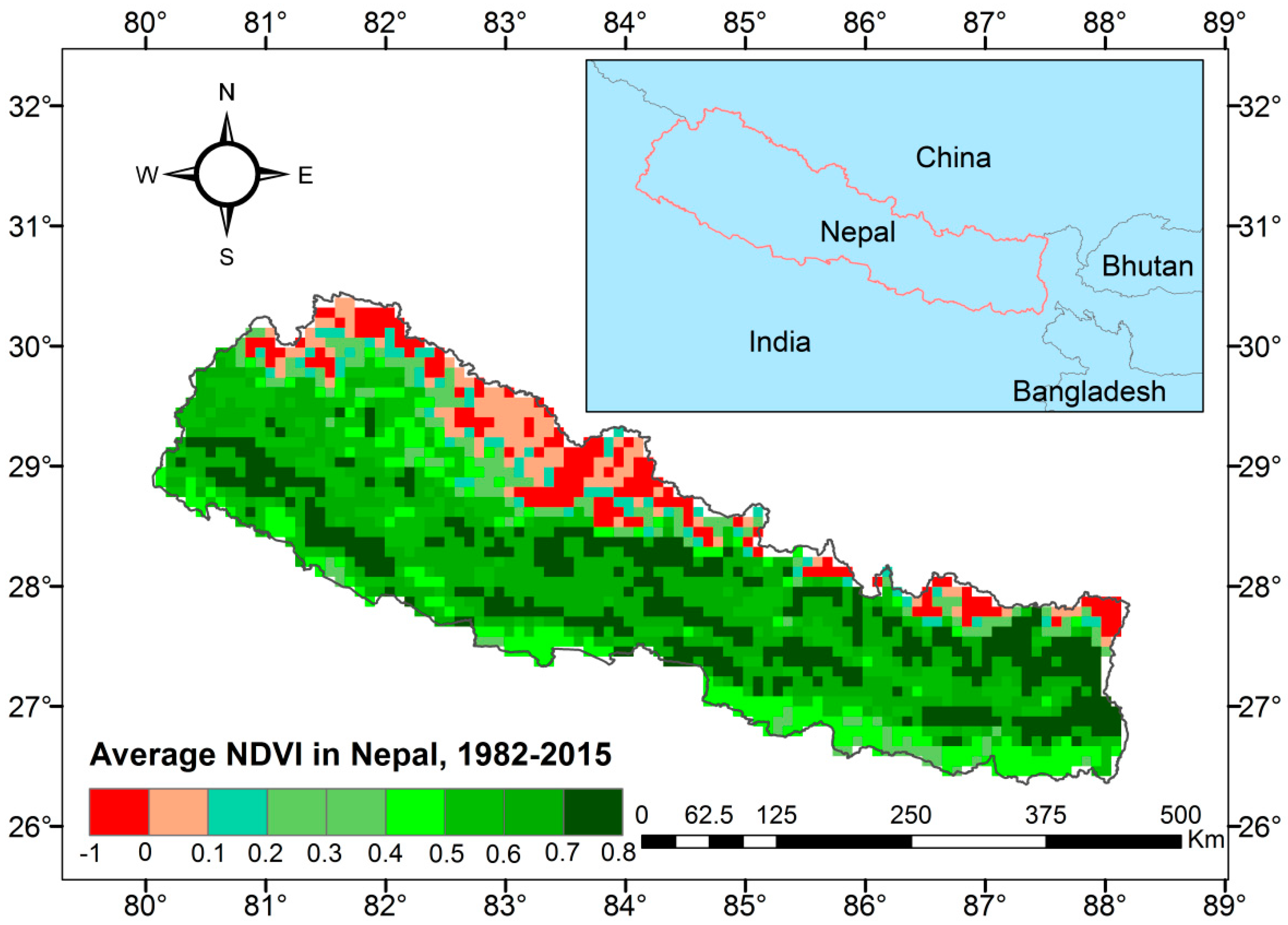
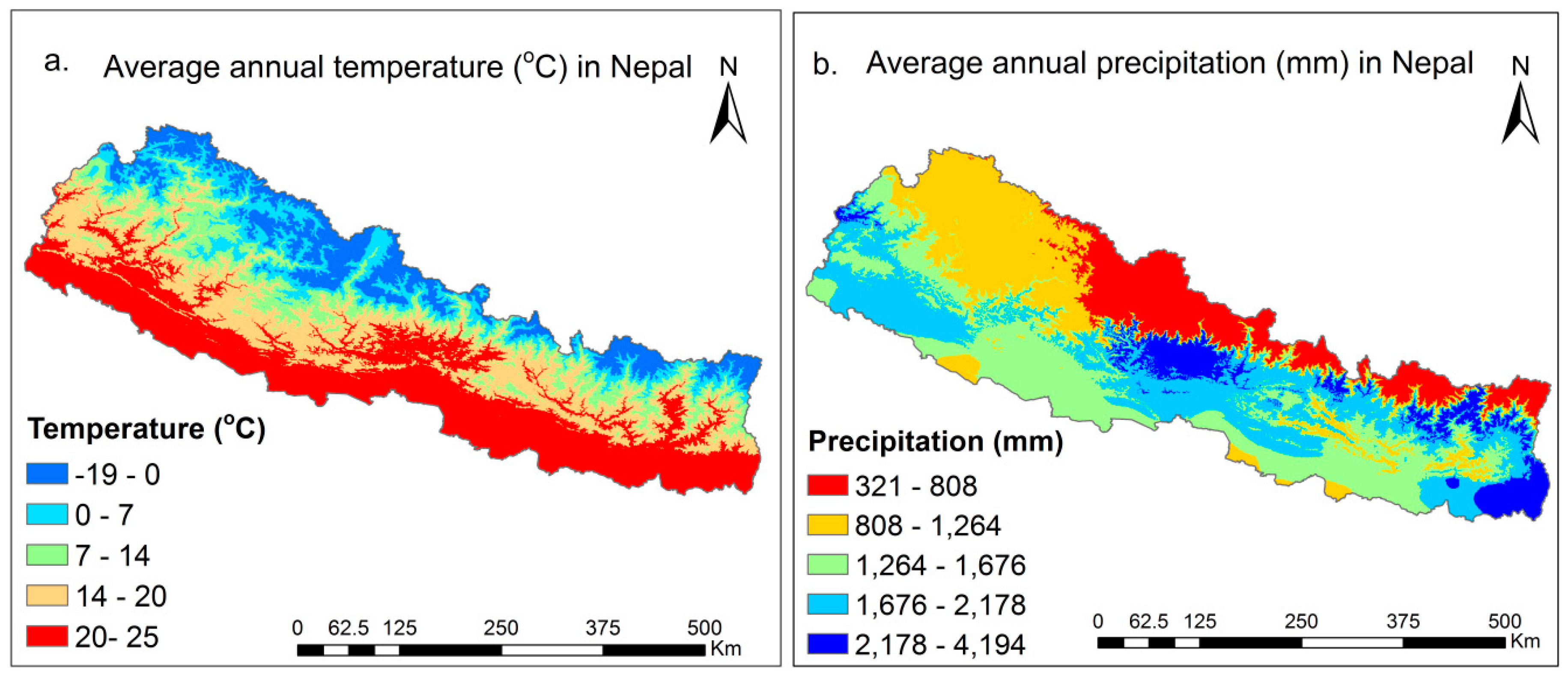
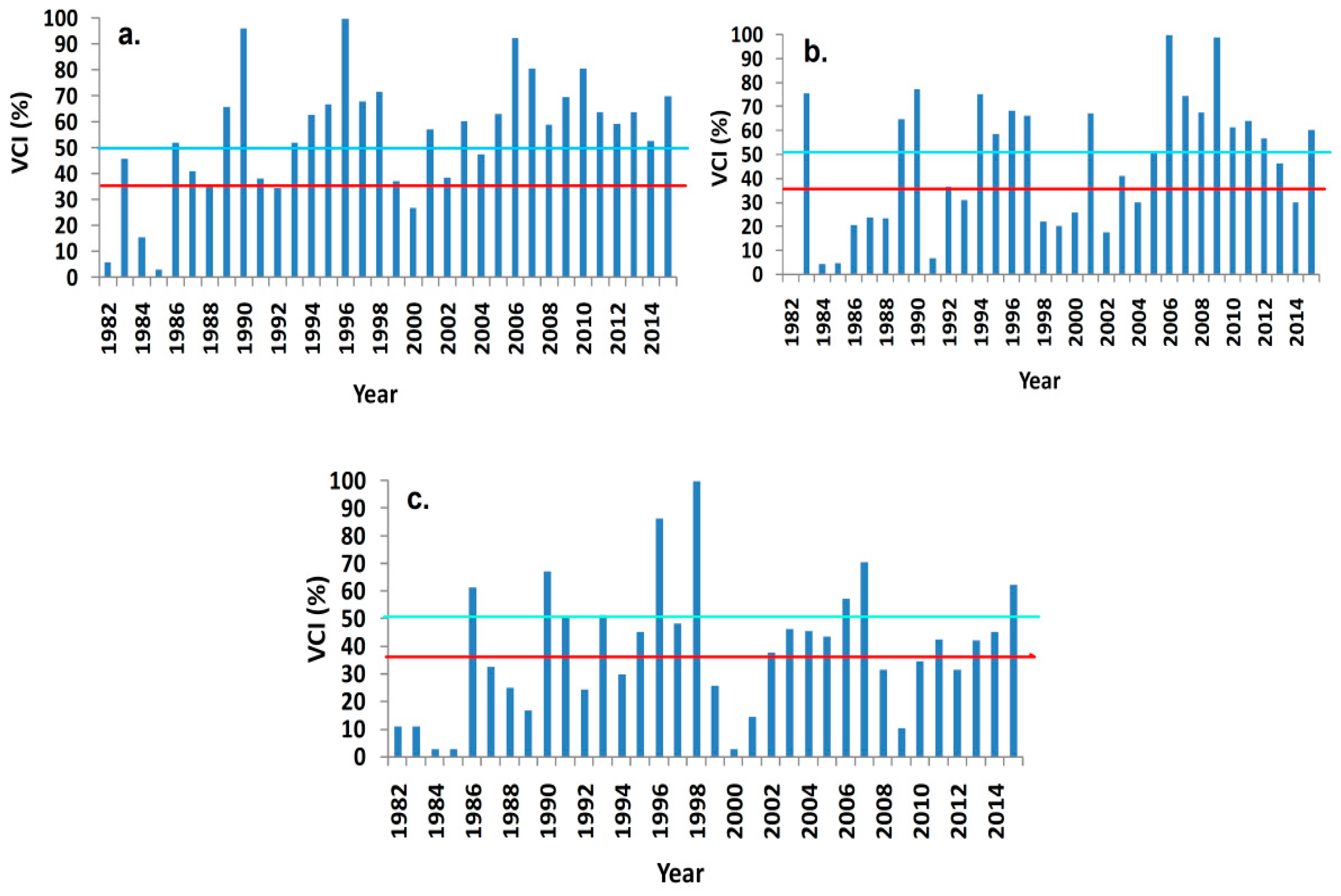
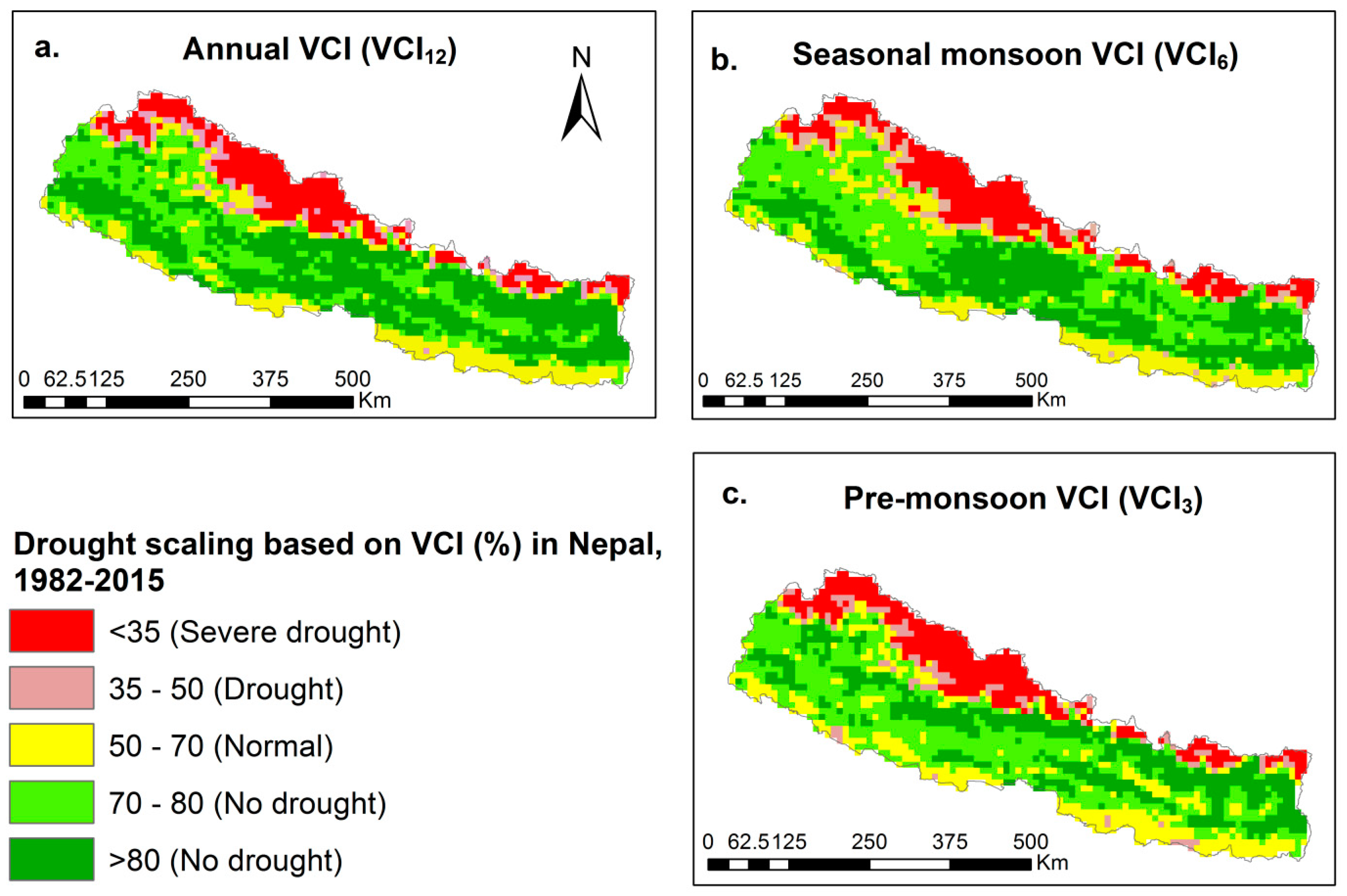
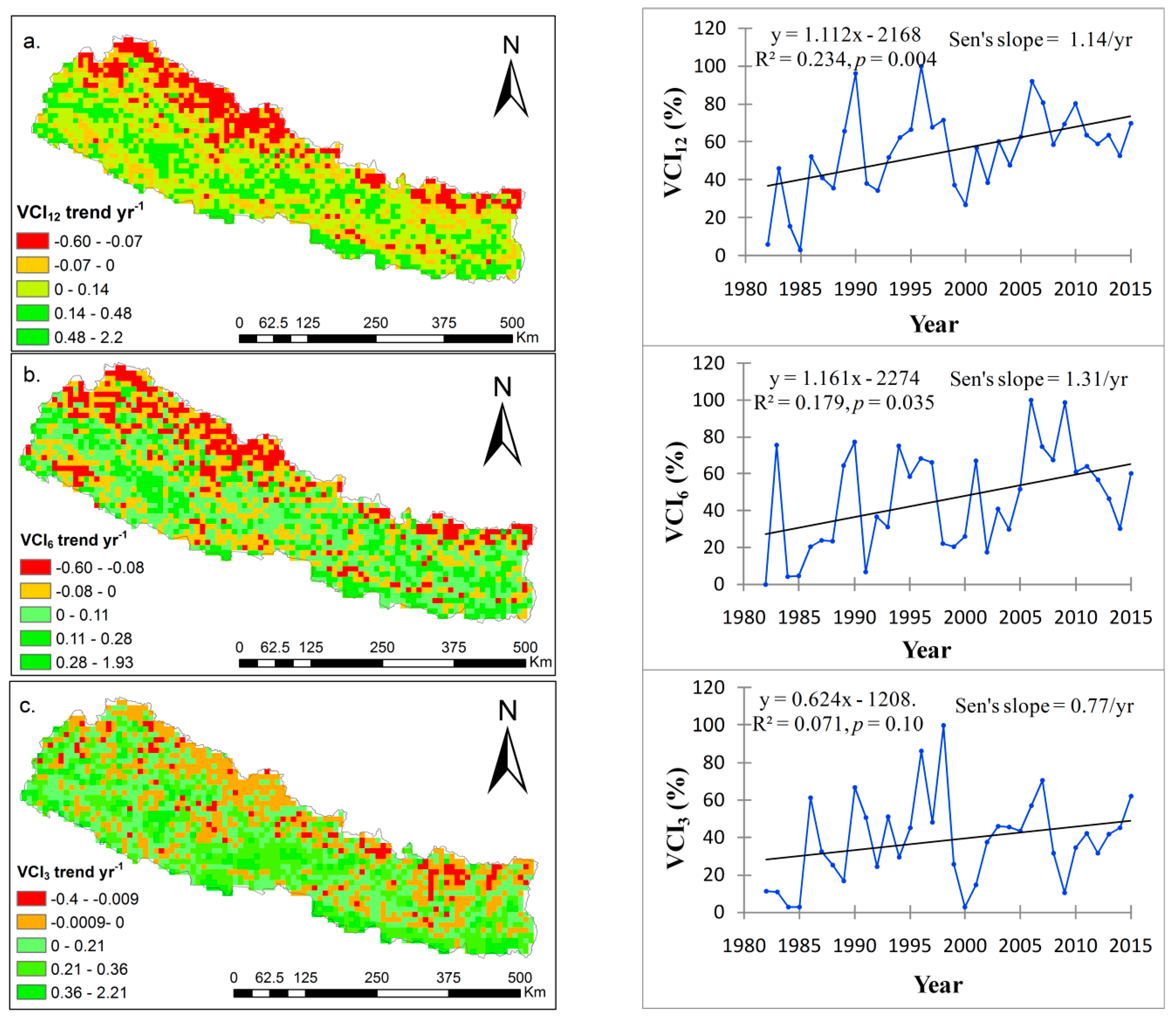
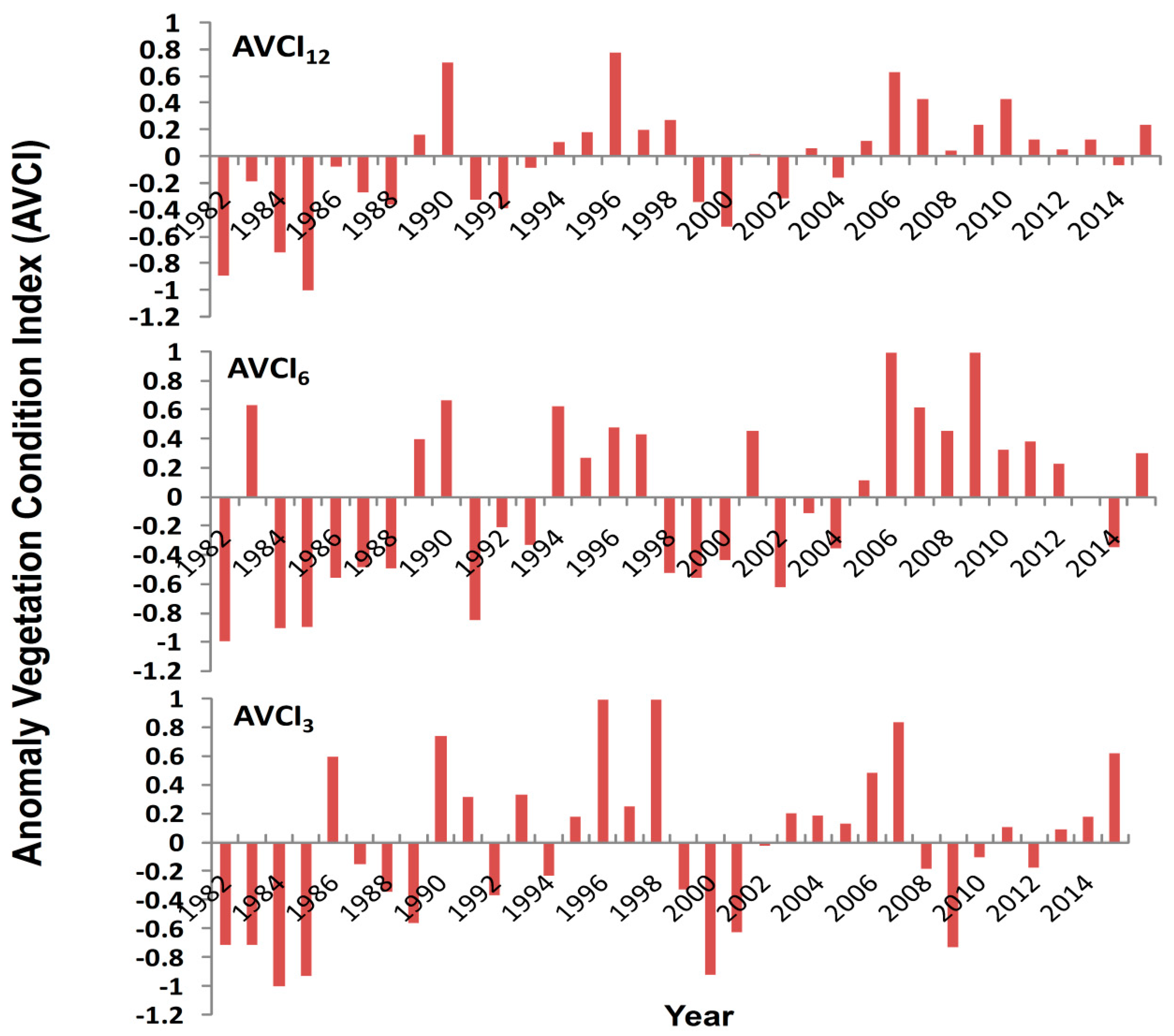
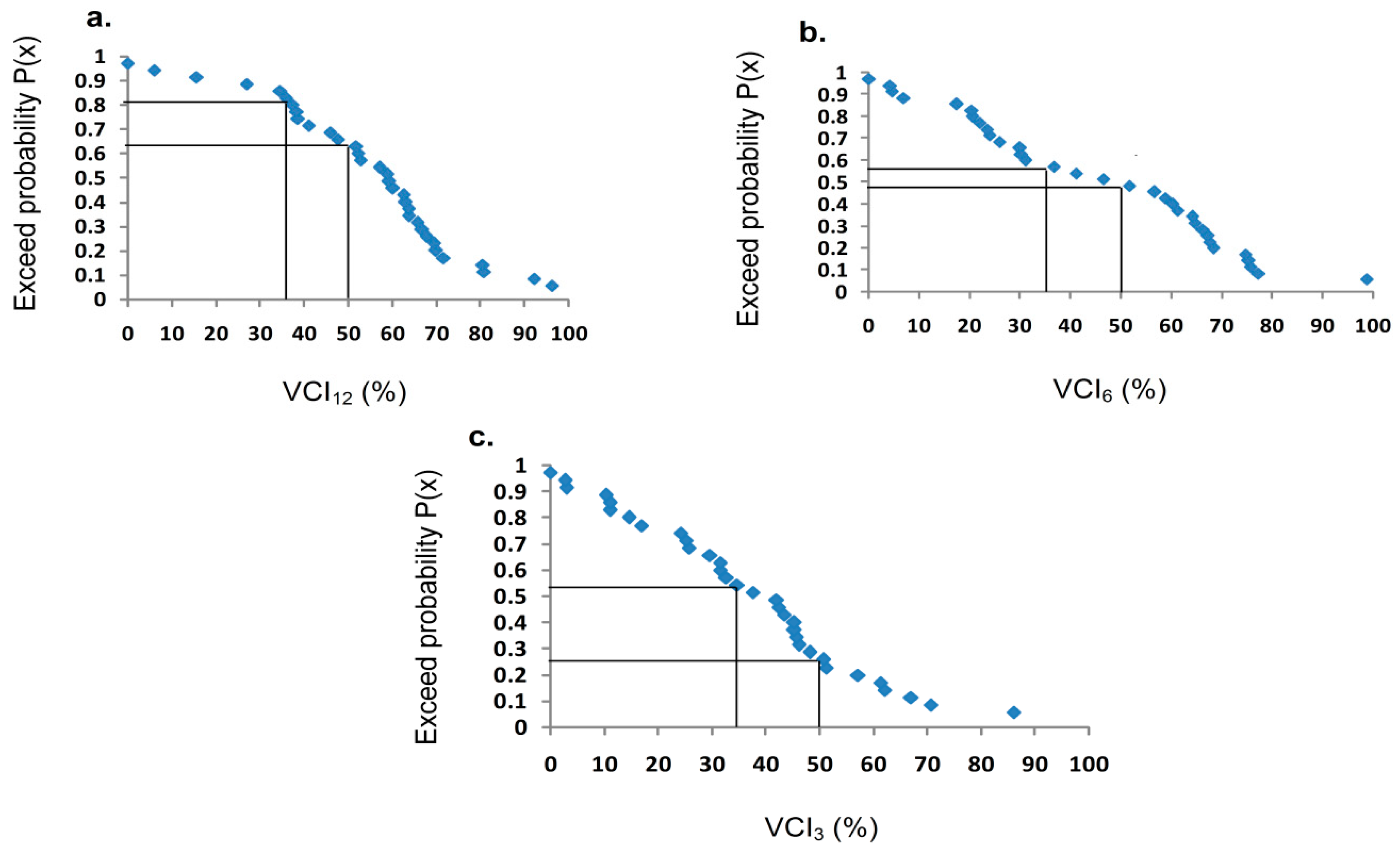
| Grade | Types | VCI (%) |
|---|---|---|
| 1 | Normal | >50 |
| 2 | Drought | 35–50 |
| 3 | Severe drought | <35 |
| Time Scale | Rt | p-Value | Rp | p-Value |
|---|---|---|---|---|
| Annual | 0.41 | 0.01 | −0.088 | 0.62 |
| Seasonal Monsoon | 0.36 | 0.03 | −0.22 | 0.2 |
| Pre-monsoon | −0.06 | 0.70 | 0.06 | 0.71 |
| Drought Scales | VCI (%) | Severe Drought Years (VCI < 35%) | Drought Years (35% ≤ VCI ≤ 50%) |
|---|---|---|---|
| Annual (VCI12) | 55.12% | 1982, 1984, 1985, 2000 | 1983,1987, 1988, 1991, 1992, 1999, 2002, 2004 |
| Seasonal Monsoon (VCI6) | 46.28% | 1982, 1984, 1985, 1986, 1987, 1988, 1991, 1993, 1998, 1999, 2000, 2002, 2004, 2014 | 1992, 2003, 2005, 2013 |
| Pre-monsoon (VCI3) | 38.45% | 1982, 1983, 1984, 1985, 1987, 1988, 1989, 1992, 1994, 1999, 2000, 2001, 2008, 2009, 2010, 2012 | 1991,1993,1995,1997,2002, 2003,2004,2005,2011,2013,2014 |
© 2019 by the authors. Licensee MDPI, Basel, Switzerland. This article is an open access article distributed under the terms and conditions of the Creative Commons Attribution (CC BY) license (http://creativecommons.org/licenses/by/4.0/).
Share and Cite
Baniya, B.; Tang, Q.; Xu, X.; Haile, G.G.; Chhipi-Shrestha, G. Spatial and Temporal Variation of Drought Based on Satellite Derived Vegetation Condition Index in Nepal from 1982–2015. Sensors 2019, 19, 430. https://doi.org/10.3390/s19020430
Baniya B, Tang Q, Xu X, Haile GG, Chhipi-Shrestha G. Spatial and Temporal Variation of Drought Based on Satellite Derived Vegetation Condition Index in Nepal from 1982–2015. Sensors. 2019; 19(2):430. https://doi.org/10.3390/s19020430
Chicago/Turabian StyleBaniya, Binod, Qiuhong Tang, Ximeng Xu, Gebremedhin Gebremeskel Haile, and Gyan Chhipi-Shrestha. 2019. "Spatial and Temporal Variation of Drought Based on Satellite Derived Vegetation Condition Index in Nepal from 1982–2015" Sensors 19, no. 2: 430. https://doi.org/10.3390/s19020430
APA StyleBaniya, B., Tang, Q., Xu, X., Haile, G. G., & Chhipi-Shrestha, G. (2019). Spatial and Temporal Variation of Drought Based on Satellite Derived Vegetation Condition Index in Nepal from 1982–2015. Sensors, 19(2), 430. https://doi.org/10.3390/s19020430






